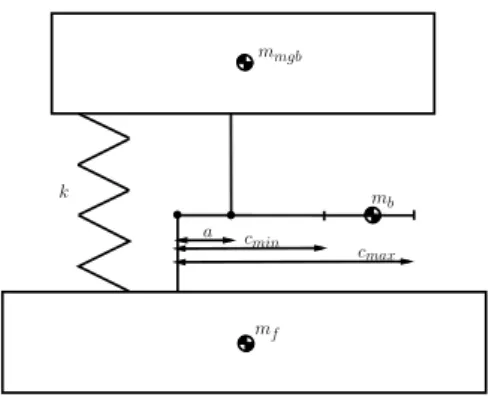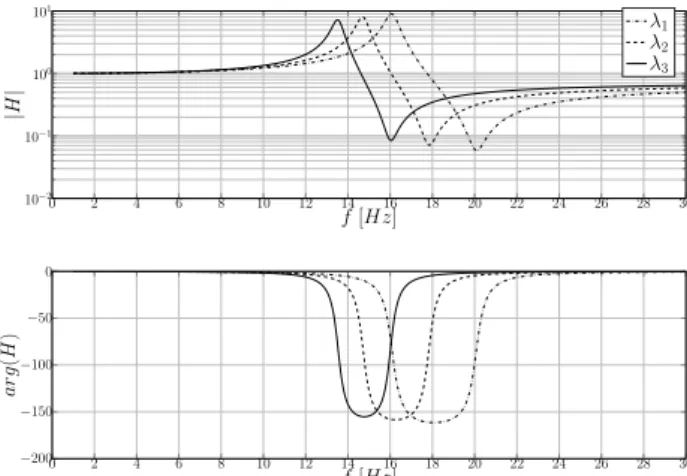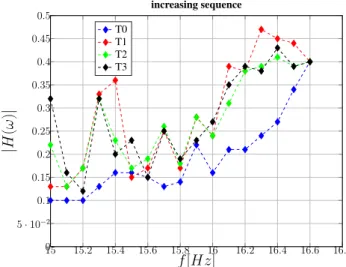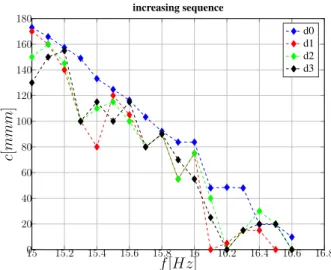HAL Id: hal-02301446
https://hal.archives-ouvertes.fr/hal-02301446
Submitted on 30 Sep 2019HAL is a multi-disciplinary open access
archive for the deposit and dissemination of sci-entific research documents, whether they are pub-lished or not. The documents may come from teaching and research institutions in France or abroad, or from public or private research centers.
L’archive ouverte pluridisciplinaire HAL, est destinée au dépôt et à la diffusion de documents scientifiques de niveau recherche, publiés ou non, émanant des établissements d’enseignement et de recherche français ou étrangers, des laboratoires publics ou privés.
BAYESIAN CONTROL OF A HELICOPTER MAIN
GEARBOX SEMIACTIVE SUSPENSION SYSTEM
-EXPERIMENTS ON A QUARTER-SUSPENSION
PROTOTYPE
Jonathan Rodriguez, François Malburet
To cite this version:
Jonathan Rodriguez, François Malburet. BAYESIAN CONTROL OF A HELICOPTER MAIN GEARBOX SEMI-ACTIVE SUSPENSION SYSTEM - EXPERIMENTS ON A QUARTER-SUSPENSION PROTOTYPE. MEDYNA 2017, Apr 2017, Sevilla, Spain. �hal-02301446�
BAYESIAN CONTROL OF A HELICOPTER MAIN GEARBOX
SEMI-ACTIVE SUSPENSION SYSTEM - EXPERIMENTS ON A
QUARTER-SUSPENSION PROTOTYPE
J. Rodriguez1*, F. Malburet21ENSAM / Airbus Helicopters
ENSAM - LSIS Aix en Provence, FRANCE
Email: jonathan.rodriguez@ensam.eu , francois.malburet@ensam.eu
ABSTRACT
This short paper considers the control of a helicopter gearbox semi-active suspension. As the future generation of helicopters will include variable engine RPM during flight, it is interesting to consider implementing control on their suspension systems in order to always optimally filter the main disturbance frequency. Here, a semi-active suspension based on the DAVI principle is developed, simulated and tested with its control algorithm based on Bayesian optimization. This control method based on the Bayes theorem is a trial/error algorithm allows to significantly reduce the number of evaluations of the real objective function for a given set of parametersθ. Thus the system is capable to fastly determine its own optimal set of parameters to maximize the objective function. The objective is to prove experimentally the ability of the Bayesian optimization to lead the learning behavior of a semi-active resonant suspension.
MEDYNA 2017 25-27 Apr 2017, Sevilla (Spain) mf mmgb k a c min mb cmax
Figure 1: semi active DAVI principle adapted to helicopter,mmgb: main gearbox and rotor,mf:
fuselage,mb: flapping mass.
1 INTRODUCTION
Fuselage vibrations are a major problem in the design of helicopters. This paper will focus on the development of a new active hybrid vibration absorber which reduces the effects of the cyclic loads (nΩ harmonics) on the helicopter structure due to the main rotor.
2 THE SEMI-ACTIVE DAVI
In 1976, Flannelly [1] presents an anti-resonant vibration absorber called DAVI which uses a rigid arm carrying a flapping mass. The inertia of the bobweight mass generates an anti-resonance at the characteristical frequencyωcdepending on some parameters : dynamic
ampli-fication, overall stiffness and flapping mass. Airbus Helicopters company developed during the 1990’s the SARIB c suspension, a DAVI suspension integrated in the helicopter between the MGB and the structure tuned to be as close as possible to thebΩ frequency (b number of blades andΩ the rotor speed).
With the arrival of variable engine RPM during flight, it is relevant to integrate some actuation in a DAVI system in order to be able ”track” the bΩ frequency and adapt the steady state parameters of the suspension to the varying frequency of the disturbing input force. One can control the DAVI dynamic amplification ratio by modifying the position of the bobweight mass on its flapping arm as in figure 1 wheremf represents the helicopter structure,mb is the
flapping mass,mmgb the main gearbox and rotor andk is the overall suspension stiffness. The
dynamic amplification ratioλ is defined as c/a and has a direct influence on the anti-resonance frequencyωc :
ωc2 =
k −λ(λ − 1)mb
(1)
Figure 2 shows the transmissibility H of the DAVI suspension for different values of λ. It is clearly visible that a suitable control of the variablec (position of the flapping mass) can modify in flight the anti-resonance frequency.
3 THE BAYESIAN OPTIMIZATION
The Bayesian optimization [2] [3] is used for computing the maximum of expensive cost func-tions. It is applicable when the estimation of the objective function for a particular case of xi
is costly and possibly noisy. The ability of the algorithm to significantly reduce the number of function evaluations before reaching the optimum value is due to the incorporation of the
0 2 4 6 8 10 12 14 16 18 20 22 24 26 28 30 10−2 10−1 100 101 f [Hz] |H | λ1 λ2 λ3 0 2 4 6 8 10 12 14 16 18 20 22 24 26 28 30 −200 −150 −100 −50 0 f [Hz] ar g (H )
Figure 2: TransmissibilityH(f ) of the DAVI suspension for different values of λ. prior belief. This prior knowledge is used to determine the new input vector xi which will be
evaluated by making a trade off between exploitation (use of prior data) and exploration of the search space. At each cost function evaluation, the algorithm computes an estimation of the functionf (x) for the complete search space Π (x ∈ Π).
From the prior knowledge of the cost function is computed the posterior distribution which represents the updated beliefs about f (x). Then, the Bayesian optimization uses an acquisition function to determine the next input vector xi+1 and measure the process response
f (xi+1).
The objective here is to adapt the dynamic amplification ratioλ i.e. the position c of the bobweight mass on the flapping arm for every solicitation frequencyω0 ∈ [ωc(cmax); ωc(cmin)].
The input parameterx represents here the position c of the bobweight mass and the cost function f (x) is mostly characterized by the acceleration level of the fuselage.
The strong assumption of the Bayesian optimization is that it is possible to consider the functionf (x) as a GP (Gaussian Process). For every input vector x, the GP will return the mean m and the covariance k of a normal distribution over the possible values of f (x) as it follows :
f (x) ∼ GP (m(x), k(x, x′)) (2) In the Bayesian method, the choice of the covariance function is very important as it determines the smoothness properties of the estimation off (x). This smoothness is generally controlled by one or more hyperparametersθ. A wide variety of covariance functions has been investigated in litterature, as in [4] we propose to use the Matern 5/2 kernel. To determine the hyperparameters of this statistical model, the ARD (Automatic Relevance Determination) method has been applied. The table 1 summarizes the main steps of the Bayesian optimization with Auto Relevance Determination method described just before.
Bayesian optimization of f(x)
While optimizedo
1 Prior knowledge availableD1:i= {x1:i, f1:i}
2 Auto Relevance Determination of θopt(i) using gradient method
3 Computation of µ and σ2
4 Computation of the acquisition function EI(x) on the search space Π 5 Maximization of EI(x) and so determination of xi+1
6 Evaluation f(xi+1)
7 i= i + 1 and go to step 1
MEDYNA 2017 25-27 Apr 2017, Sevilla (Spain) mf M ks screw joint mb MGB strut kθ bobweight arm w(t) ks ks motor aref af shaker c parallelogram
Figure 3: Test setup scheme.
4 EXPERIMENTS
As explained previously, the system we control here with the Bayesian optimization is the semi-active SARIB c from Airbus Helicopters. The test setup represents an isolated MGB strut linked to a semi-active DAVI bobweight arm. The figure 3 represents a diagram of the test bench (no pictures allowed due to Airbus confidentiality policy), one can notice that the flapper arm is linked by a fitting to a mass mf representing the helicopter structure. In order to keep all
movements in a plane, a mechanical parallelogram is added to the experimental set-up.
Three different learning sequences have been used to teach the program. We define a learning sequence as the order of appearance of every frequency ω within the antiresonance bandwidth of the semi-active DAVI[ωc(cmax); ωc(cmin)].
15 15.2 15.4 15.6 15.8 16 16.2 16.4 16.6 16.8 0 5 · 10−2 0.1 0.15 0.2 0.25 0.3 0.35 0.4 0.45 0.5 f [Hz] |H (ω )| increasing sequence T0 T1 T2 T3
Figure 4: Increasing sequence - suspension transmissibility.
The real optimal positionscref(ω) ∀ω ∈ Π are also computed to set a reference vector
d0. As a result (see 4 and 5), the Bayesian optimization always finds a solution acceptable for the mass position giving a transmissibility around 0.45 for the worst results and 0.1 for the best ones. In addition to the Bayesian optimization, it has been added a learning method to keep in a database the ”good” positions tested for each frequency. The objective is to reduce the number of iterations necessary to the algorithm to find the optimal position.
15 15.2 15.4 15.6 15.8 16 16.2 16.4 16.6 16.8 0 20 40 60 80 100 120 140 160 180 f [Hz] c[ m m m ] increasing sequence d0 d1 d2 d3
Figure 5: Increasing sequence - mass position.
5 CONCLUSION AND PROSPECTS
The main difficulties encountered during the development of the control algorithm were to deal with the resonant behavior of the DAVI. Controlling a dynamic system near its anti-resonance or resonance frequency implies fast and unstable phase changes which makes harder having a clean and fine tuning. The fact that this optimization technique is based on a stochastic, not deterministic model which is updated using prior knowledge on every measurement made, presents a strong advantage in comparison to other semi-active control methods. There is no need of a complex mathematical model of the system or prior identification.
Good results were achieved in terms of vibration isolation : a suspension transmissibility going from 0.1 to 0.41 and no absurd final mass positionc were observed in spite of the system noise. The learning sequence order demonstrated to have a limited impact on the final results.
As a conclusion, control adaptivity, learning methods and auto-tuning of control para-meters even without particular mathematical model of the system or prior asumptions are the current keys for the future evolutions of the dynamics control field.
REFERENCES
[1] W.G. FLANNELLY. The dynamic anti-resonant vibration isolator. AHS, 1976.
[2] Vlad M. Cora Eric Brochu and Nando de Freitas. A tutorial on bayesian optimization of expensive cost functions, with application to active user modeling and hierarchical rein-forcement learning. 2010.
[3] Jan Peters Marc Peter Deisenroth Roberto Calandra, Andr Seyfarth. Bayesian optimization for learning gaits under uncertainty : An experimental comparison on a dynamic bipedal walker. Annals of Mathematics and Artificial Intelligence, 2013.
[4] Ryan P. Adams Jasper Snoek, Hugo Larochelle. Practical bayesian optimization of ma-chine learning algorithms. Advances in Neural Information Processing Systems, 2951-2959, 2012.



